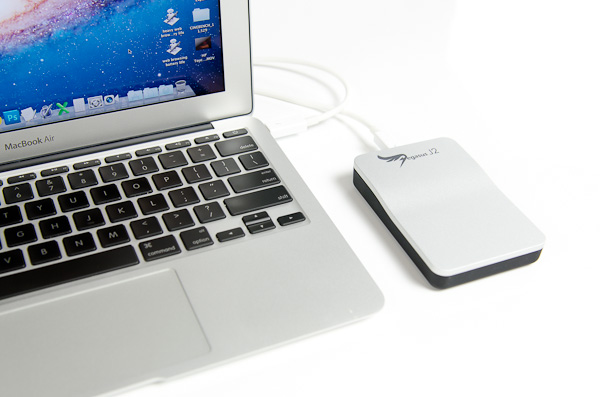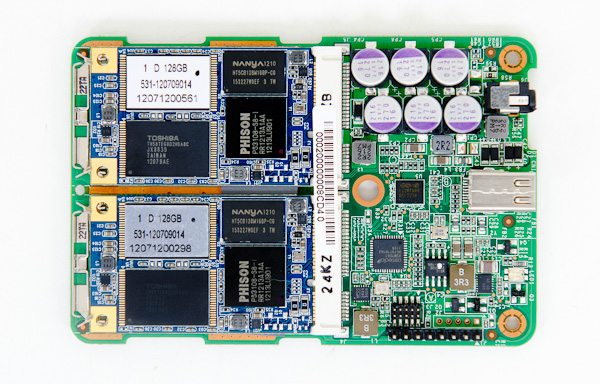Promise Pegasus J2 Review: The Smallest High Performance Thunderbolt Drive
by Anand Lal Shimpi on September 2, 2012 1:00 PM ESTFinal Words
I really like the uniqueness of the Pegasus J2. Two 6Gbps mSATA drives in a well-built bus powered enclosure that gains additional performance when plugged into the wall is a great way to deliver the best of both worlds. Sequential IO performance, particularly on the read side is amazing. You can get the performance of a 6-drive Pegasus R6 in a fraction of the volume. The chassis is well built and the design is functional.
The big issues with the J2 are its capacity constraints and the Phison controllers used by the integrated SSDs. The former is really a limitation of current NAND die sizes. The best 2-bit MLC NAND shipping today still tops out at 8GB per die, with a maximum of 8 die in a package (64GB per package). It's only really possible to fit 4 NAND packages (256GB) on a standard mSATA board, which limits the J2 to a maximum capacity of 512GB. If that's all the space you need for an external work drive (e.g. as a video project drive for a rMBP or MacBook Air), then you'll be fine, but otherwise it can be an issue.
My other complaint has to do with the use of Phison controllers on the mSATA SSDs. I understand the appeal, but there are simply better options on the market. I'd much rather see something like the Micron C400 mSATA drive integrated into the J2.
The concept behind the J2 is neat and honestly makes a lot of sense. The right way to do this would be to integrate custom form factor SSDs into a tiny Thunderbolt enclosure (e.g. Zenbook Prime/MacBook Air form factor). A larger form factor would allow you to hit 512GB per drive (or more), while sticking with an internal RAID-0 would help take advantage of what Thunderbolt has to offer. You only really need two good 6Gbps SSDs to max out Thunderbolt after all.
Kudos to Promise on breaking the mold with the Pegasus J2, but I'd at least like to see better SSD controllers used inside.












24 Comments
View All Comments
likethesky - Saturday, September 8, 2012 - link
Why go TB, when USB 3.0 is just about as fast? Or am I wrong about that for SSDs?Zds - Sunday, September 9, 2012 - link
USB 3.0 is 5Gbps, TB is 8Gbps - and this device uses all that on sequential reads, hitting 770MB/s.repoman27 - Tuesday, September 11, 2012 - link
Well, SuperSpeed USB is 5 Gbps with 8b/10b encoding, so really only 4 Gbps, and realistically tops out at 400 MB/s due to protocol overhead. If you're using USB 3.0 drivers and/or hardware that only support standard Bulk Only Transfer mode, throughput will be considerably less than that.Thunderbolt is 2x 10.3125 Gbps channels per port with 64b/66b encoding which brings them down to 10 Gbps. While most Thunderbolt controllers have a PCIe 2.0 x4 back end, the Port Ridge controller used in this device only provides a single 10 Gbps Thunderbolt channel paired with a PCIe 2.0 x2 connection.
A PCIe 2.0 lane is 5 Gbps but also uses 8b/10b and has its own protocol overhead, which in practice results in throughput of about 400 MB/s, although better results can be achieved with larger TLP payload sizes.
So any Port Ridge based Thunderbolt device would be limited to around 800 MB/s, which is exactly what we see here.
There's one more element to the equation though, and that's the SATA controller. Most USB 3.0 to SATA bridges on the market at the moment only support SATA 3Gb/s, which limits them to less than 300 MB/s (8b/10b strikes again). Meanwhile, most SATA 6Gb/s controllers used in Thunderbolt devices only have a PCIe 2.0 x1 connection which drags them down to 400 MB/s. Which makes me confused about the Pegasus J2's performance, because that's what we would expect from a single ASM1061 controller. I'm guessing there's a second one on that board somewhere.
Zds - Sunday, September 9, 2012 - link
What are the dimensions of the device? It feels strange to applaud the small size, but not tell _how_ small exactly it is..